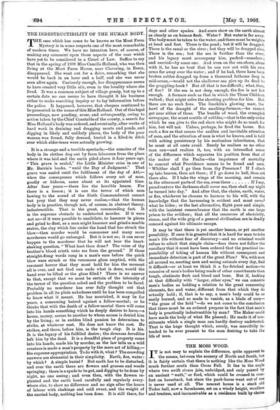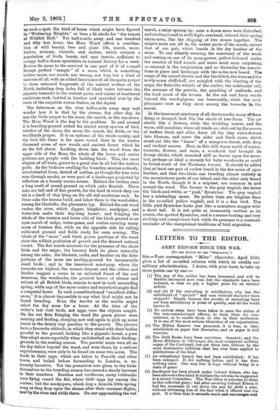THE MOSS WOOD.
IT is not easy to explain the difference, quite apparent to the senses, between the scenery of North and South, but it is fairly certain that there is nothing like the Moss Wood much further south than Cross Fell. It lies in the angle where two swift rivers join, unbridged, and only passed by an ancient " wath," or ford, which could be crossed in com- fort on horseback, but since the pack-horse went out of use is never used at all. The nearest house is a stark old Tudor hall, now a farmhouse, set on a windy height, woodless and treeless, and inconceivable as a residence built by choice on such a spot, the kind of house which might have figured in "Wuthering Heights," or been a fit abode for " the tenant of Wildfell Hall." Yet half-a-mile away, and one hundred and fifty feet lower, the Moss Wood offers a combina- tion of wild beauty, tree and plant life, marsh, moor, timber, streams, warmth, and shelter, which attracts a population of birds, beasts, and rare insects sufficient to occupy half-a-dozen specialists in natural history for a week. It owes its name to the survival in one part of it of a small though perfect " sample " of a moss, which is something neither moor, nor marsh, nor swamp, nor bog, but a kind of mixture of all, with an added luxuriance of all the parts proper to these untamed fragments of the natural surface of the North, including deep holes full of black water between the gigantic tussocks in the wettest parts, and cairns of weathered sandstone rock, bedded in heather and sprawled over by the roots of the exquisite rowan bushes, in the dryest.
The fisherman on the river half-a-mile away may well wonder how it is that by the stream, day after day, he sees the birds proper to the moor, the marsh, or the sea-shore. The Moss Wood is the key to the problem. In and around it is breeding-ground suited for almost every species of bird, whether of the shore, the moor, the marsh, the fields, or the woodlands proper. It is an epitome of the whole county, and the bird life there is far more varied than in the twelve thousand acres of new woods and ancient forest which lie on the fell above. Looking down into the wood from the upper side of the Moss, the whole of the lower and centre portions are purple with the budding birch. This, the most elegant of all trees, grows to a great size in all but the wettest parts. As the buds are swelling the branches assume a cloudy, unsubstantial form, devoid of outline, as though the tree were seen through smoke, or were part of a landscape projected by reflection on a loosely woven screen. Behind the birches rises a long swell of sound ground on which oaks flourish. These oaks are tall and of fine growth, for the land in which they are set is a knoll of clay lying on the old red sandstone rock. In these oaks the herons build, and below them in the wood-elder, among the bluebells, the pheasants lay. Behind the oak wood rushes the river, which dipper, kingfisher, sandpiper, and water-hen make their day-long haunt; and fringing the whole of the western and lower side of the birch ground is an open marsh of sedge, water-grass, and rushes covering many acres of treeless flat, while on the opposite side lie rolling cultivated ground and fields ready for corn sowing. The whole of the " moss " and birch grown portions of the wood show the wildest profusion of growth and the densest natural covert. The fiat marsh accounts for the presence of the shore birds and the snipe; the heronry finds its place naturally among the oaks; the thickets, rocks, and heather on the drier portions of the moss are nesting-ground for innumerable small birds ; and in the innermost sanctuary, where the tussocks are highest, the mosses deepest, and the alders and birches suggest a scene in an unburied forest of the coal measures, the woodcocks, the greatest lovers of silence and retreat of all British birds, remain to nest in each succeeding spring, while any of the rarer crakes and waterfowl might find a congenial home. In such a combination of " excellent differ- ences," it is almost impossible to say what bird might not be found breeding. Even the harrier or the merlin might select the dry moss for a home. At the time of the writer's last visit birds, not eggs, were the objects sought. On the wet flats fringing the wood the green plover were running and feeding, stooping now and again to pick up some insect in the dainty way peculiar to the peewit. The plovers have a favourite attitude, in which they stand with their bodies parallel to the ground, looking like a gigantic locust, a pose they adopt more especially when undisturbed on their feeding- grounds in the nesting season. The peewits' nests were all on the dry fallow beyond the wood, and even there, by a curious capriciousness, were only to be found on some two acres. The trade in their eggs, which are taken to Penrith and other towns and boiled before forwarding to London, is ex- tremely lucrative. Yet the protection now given to the birds themselves in the breeding season has caused a steady increase in their numbers. Restless and vociferous, many redshanks were flying round the flat, where their eggs lay among the rushes; but the sandpipers, which sing a humble little spring song as they drop upon the stones after their constant flights, nest by the river and abide there. On our approaching the wet marsh, a snipe sprang up; soon a dozen more were disturbed, and circling round in swift flight overhead, uttered their spring alarm-note, like the chipping of two stones together. The snipe's nests are all in the wetter parte of the marsh, except that of one pair, which breeds in the dry heather of the moss. To one silently entering the sanctuary of the wood, and resting on one of its moss-grown, yellow-lichened rocks, the number of bird sounds and notes must seem surprising, so unusual is the conjunction, and so dissimilar the associa- tions in place and landscape with the notes now heard. Tho songs of the missel-thrush and the blackbird, the wren and the newly-come chiffchaff, are mingled with the bleating of the snipe, the flute-like whistle of the curlew, the redshanks' call, the screams of the peewits, the quacking of mallards, and the loud croak of the herons. In the oak and larch woods beyond, the wood-pigeons coo incessantly, while the cock pheasants crow as they strut among the tussocks in the marsh.
In the innermost sanctuary of all, the tussocks, many of them dying or decayed, look like the stools of tree ferns. The air smells like a fernery, while the trickling waters, and the warm, still sunshine, where all winds are shut out by the screen of leafless birch and alder, force all the tiny water-flowers into blossom, and cover the alder and birch roots, which stand out like the " knees " of a mangrove forest, with deep and verdant mosses. Here, in this still, warm world of waters, tussocks, flowers, and moss, a woodcock had brought its downy chicks, which crouched still as leaves upon the moss- bed, perhaps as ideal a nursery for baby woodcocks as could be found south of the Northern forests. It should be added that at least one pair of curlew breed in the few acres of open heather, and that two birds, one breeding almost entirely in the mountainous parts of our island, and the other only found in the North, though it is a migrant, are common in and around the wood. The former is the grey wagtail, the latter the black-and-white, or "pied," flycatcher. The grey wagtail has a misleading name. Its yellow tints are brighter than in the so-called yellow wagtail, and it is a fine bird. The little pied flycatcher looks just like a miniature magpie with a short tail. It is not quite so incessantly restless as its cousin, the spotted flycatcher, and is a neater-looking and very striking and conspicuous bird, while its presence is a constant reminder of the unexplained traditions of bird migration.











































 Previous page
Previous page